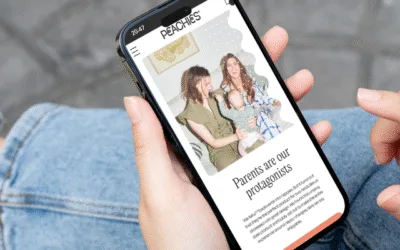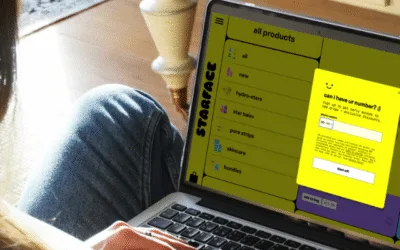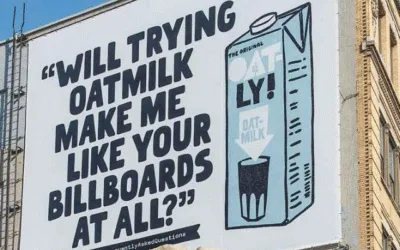Peachies beat Pampers by selling sleep, not nappies. Learn their Ladder of Why messaging trick to make your copy resonate.
How bad reviews can make the best ads (with examples from Oatly, Collider & more)
Bad reviews are part and parcel of running a brand. Learn how to use copy to flip the script on negative feedback and win new customers over.

Get pro copy tips, branding tricks and e-comm insights directly to your inbox every Tuesday.
Recently, we’ve been noticing a bit of a resurgence of reverse psychology in copywriting, especially on social media.
In other words, we’ve been seeing loads of brands sharing bad reviews from customers as a marketing tactic.
Like this ad for AF beer we got targeted with the other day 👇️
And it’s no surprise why it’s coming back: it works. (As the cans of Collider beer in my chiller can attest to.)
So this week, we thought we’d dig into why it works, break down a few brands that nail it and give you a framework to do it right.
Let’s dive in 👇️
💡 This week’s big idea
Did you know that sharing bad reviews can actually make your brand more likeable.
Sounds counterintuitive, right? But science backs it up.
The Pratfall Effect suggests that when brands (or people) show a minor flaw, they become more relatable and trustworthy.
That’s because perfection can feel intimidating or fake, while small imperfections make us more human.
Think of Jennifer Lawrence falling up the stairs at the Oscars. Human and endearing.
Plus, a 2023 study found that brands that acknowledge their flaws see increased trust and engagement, with customers more likely to rally around them. And when done well, sharing bad reviews can even drive more sales.
So why are brands still deleting, hiding, and burying negative feedback?
Let’s look at how to use bad reviews to build connection, loyalty, and brand affinity.
Remember that viral trend where it seemed like every coffee shop or micro-brewery had the same chalkboard outside saying something like this? 👇️
Come in and try the worst IPA Dave from TripAdvisor ever had in his life.
The first time you saw it, it was funny. The 73rd time? Not so much.
But like all trends, there was some serious psychology behind it.
And while trends change like the wind, the way our brains work is pretty much set in stone, so it’s no surprise that it’s making a bit of a comeback at the moment.
Tricking our brains into liking your brand
There are a lot of things going on under the hood of this one, so let’s break them down.
👉️ The Pratfall Effect AKA being flawed makes people like us more
Psychologist Elliot Aronson’s 1966 research found that highly competent people become more likable when they make a small mistake. However — key point here — that only happens if they’re already perceived as good at what they do
👉️ Customers don’t trust perfect brands
A 2024 International Journal of Marketing Studies study found that brands that show a mix of good and bad reviews are perceived as more trustworthy than brands with only positive feedback. Why? Because a 5-star rating with no criticism feels fake. Customers actually trust brands more when they see a mix of real opinions.

👉️ Psychologically, we’re still teenagers rebelling against our parents
When people feel manipulated or forced to believe something, they resist. This is called psychological reactance. This works both ways, where if a product is too perfect, we rebel against it as “too good to be true”, but if we feel like they’re being warned away, we’re usually more inclined to try the product. (“People say it’s terrible? Well, I’ll be the judge of that!”)
👉️ The Curiosity Effect and information gaps
When our brains detect a contradiction between what we’re being told and what we think we know, it creates an itch that we have to scratch. Psychologist George Loewenstein called these information gaps.
And while this little trick is responsible for some of the most egregious copywriting of the last few decades — AKA, headlines like “You’re never going to believe the 10 worst foods to eat! Number 8 will shock you!” — it’s also the reason why sharing bad reviews from your brand account is so good at grabbing eyeballs. That curiosity gap is enough to get them reading.
👉️ In-crowd vs out-crowd dynamics
Social Identity Theory tells us that we’re wired to form in-groups and out-groups. We divide people — and brands! — into “like us” and “not like us” categories in our heads all day long.
(10 points to us for resisting a Kendrick Lamar gif here.)
So when you share a bad review in a playful way, you’re not just creating curiosity and likability, you’re also inviting your audience into an in-group of people who “get it”. (Cleverly, it also leans into the natural human tendency to favour and defend one’s in-group against out-group criticism, turning customers into vocal brand evangelists.)
3 ways you can use this in your ads 👇️
Have some fun and spark curiosity like Oatly
Yes, yes… we know. Yet another example from Oatly.
But most of the time, Oatly’s copy isn’t just fun and eyeball-catching, it’s also rooted in smart thinking and psychological principles.
And this one is no different.
Not only does the swearing grab your attention — cough you can learn more about that here cough — but the fact they’re sharing a negative review doubles down on the impact made by the swear word.
Then — lo and behold — in the copy below the headline, they start to lean into the us vs them of it all. (If you’re in the UK, this is all very Marmite coded.)
They add in a bit of Bandwagon Effect (“a growing number of people”) and you’re left with an ad that makes you want to try
Oatly so you can pick a side. Wicked smaht.
How you can use this:
share a strongly-worded negative review and lean into the fact that you’re comfortable with not being for everyone. Something like this 👇️
Smells like a grandma’s attic! Overpowering! Too much lavender!
Yep, those are real things people have said about our candles. And you know what? We get it. Scent is personal. Some people love bold, room-filling fragrances, while others prefer something a little more subtle.
Well, our candles don’t hold back. They’re made to make a statement. Whether it’s our fresh bursts of citrus, the deep musks of sandalwood, or the warm hugs of vanilla, our candles are in-your-face, unapologetically bold.
So if you love a candle that actually fills the room (instead of barely whispering “hi” from the corner), you’ll probably love ours. If not, well… they make a great gift for someone else (or someone you don’t like).
Try it. Love it. Or pass it on. Either way, your space will never smell boring.
Remember, keep it playful and self-aware.
Humour and having your tongue firmly in your cheek are key here, so avoid any implication of being mean. You want to gently tease your customers, not outright mock them.
(A Frontiers in Psychology study found that brands that mock customers lose credibility and brand loyalty. Shocking, right?)
Turn your bad review into a badge of honour like Snowbird

If you’ve got your target audience absolutely dialed in, you can use negative reviews to dabble in a bit of exclusionary marketing. (AKA, saying who you’re absolutely not selling to.)
Snowbird, a Utah ski resort, are a master of this. They have taken their “worst” reviews and turned them into print ads with headlines like “There are no easy runs” and “Too advanced”.
The effect? A subtle variation on the us vs them where you appeal to hardcore fans of your product by saying “this isn’t for beginners”.

How you can use this:
Flip a negative review into a badge of honour that positions your brand as for only a certain kind of person. Something like this 👇️
⭐️ “I like spicy food, but this is ridiculous. One drop and my mouth was on fire for an hour. My husband took a bite and started sweating like he ran a marathon. Who actually enjoys this? Not fun!”
— Lisa, Portland, OR
This isn’t your average grocery store hot sauce. It’s fire in a bottle. If you can’t handle the heat, no worries—there’s always ketchup. But if you’re ready to level up, welcome to the big leagues.
Try it… if you dare. 🔥
Remember: choose reviews that highlight personal preference, not any kind of objective failure.
✅ “Too spicy for me” → This tells the right customers that the product is flavorful and bold.
❌ “This arrived broken and customer service never responded.” → undermines trust in your brand.
Use bad reviews to double down on your positioning like Collider 👇️

Although there are a few things we’d tweak about this ad from Collider to make it even more effective, it’s a really good lesson in taking a common complaint—price—and flipping it into a strength.
By using a review to position their product as premium, high-quality, and worth the cost, Collider get the opportunity to emphasise the craftsmanship, unique ingredients, and real benefits of their beer.
By the end of the ad, the price doesn’t just seem justified, you also probably feel like this beer is better quality than the competition too. (This is a good example of Effort Justification in action AKA we think things that take longer to make are worth more money.)
How you can use this:
Use a negative review about a common objection to turn it into a strength. Something like this 👇️
“Too expensive.” “Wish it was cheaper.”
We hear it all the time.
But here’s the thing, while we’d love our shakes to be cheap, we can’t do that without compromising on the quality of the ingredients that you’re putting into your body.
Sure, we could cut the powders with bulking agents. But we’d rather pack every serving with premium plant-based protein, slow-releasing carbs, fiber, adaptogens, and essential vitamins.
No fillers. No junk. Just real nutrition designed to fuel your body the way it deserves.
We don’t cut corners. We don’t water it down. We make real food for real results.
Are there cheaper shakes out there? 100%. But they don’t keep you full from breakfast to noon. They don’t support your body the way they should. And they definitely don’t taste this good.
Remember: use bad reviews to handle common objections and subtly position yourself as better than your competitors. (Or, at least, the brands in your category that you’re at odds with.)
Dive into more free tips and tricks 👇
How Starface use orthography to build a killer brand voice their customers love
The words you write matter. But so do your full stops, emojis and lowercase letters. Learn how to turn punctuation into a powerful part of your brand voice.
Why Oatly’s brand voice is so damn good (and how yours can be, too)
We dig into the three layers of brand voice (10,000ft, 1,000ft, ground level), show how Oatly nails each one and how you can do it for your own brand.
The weekly newsletter that takes your brand’s copy from “meh” to “hell f*cking yeah!”
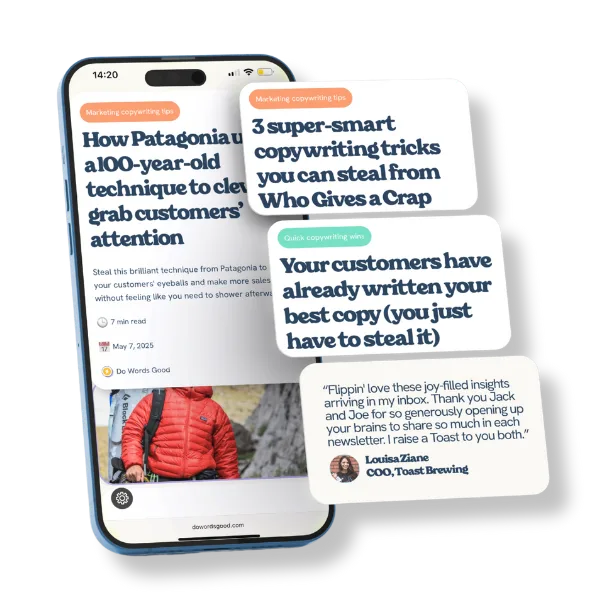
Read every week by legends at brands like these











